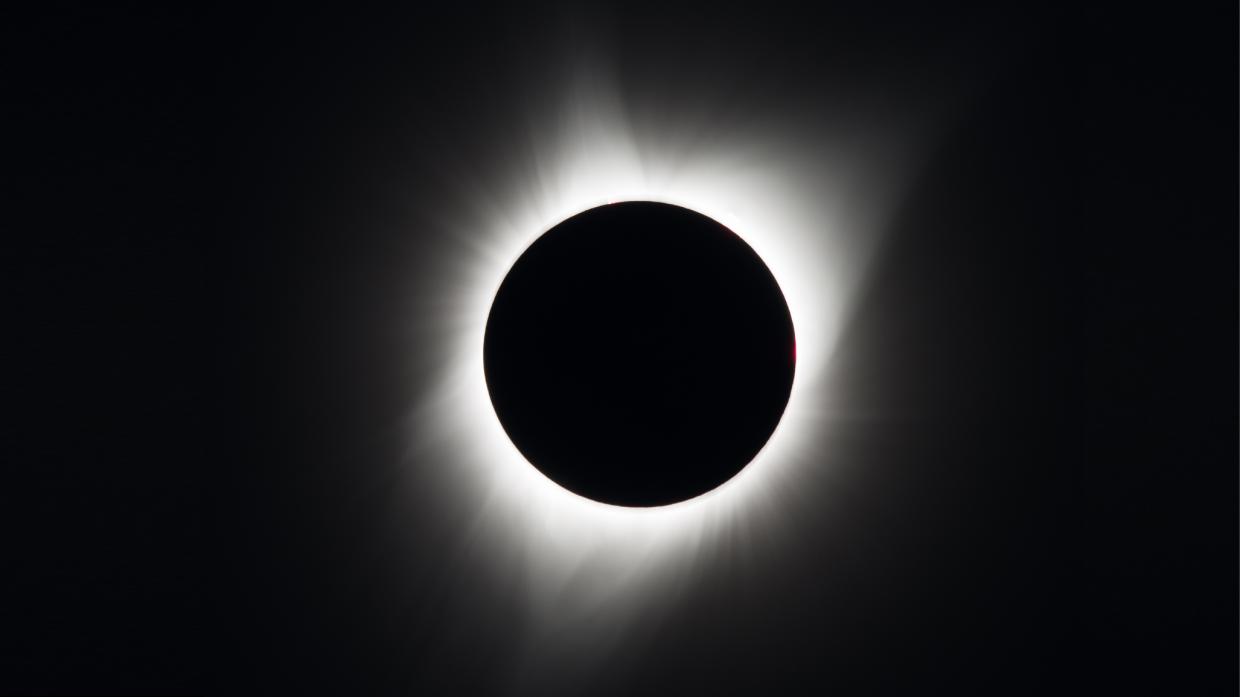
A total solar eclipse is coming to North America!
- Monday, April 8, 2024, a total solar eclipse will be seen in the US from Texas to Maine; all of North America will have at least a partial solar eclipse.
- How Can You See It?
You never want to look directly at the sun without appropriate protection. That could severely hurt your eyes. However, there are numerous safe ways to view an eclipse. Please see safe viewing techniques below.
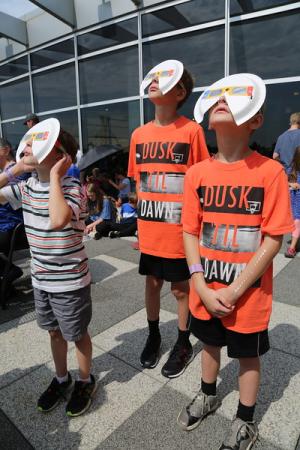
Resources
- What is a Solar Eclipse?
- Maps and Times
- Hands-on activities
- At-home activities and apps
- Safe Viewing (Eclipse Glasses, Shadows, Pinhole Viewers, and Projections)
- What should I do with my used solar eclipse safety viewing glasses?
- Handouts
- Community Event Planning and Preparation
- Finding STEM Experts
- Live Streaming
- Citizen Science and Community Science Projects
- Multimedia - Animations and Visualizations
- Promotional Images
- Taking Photos
- Posters
- Slides
- Videos
- Schools and Libraries
- Planetarium Shows
- Training for Staff and Volunteers
- Books and Booklets
- Sensory Resources
- Cultural Connections
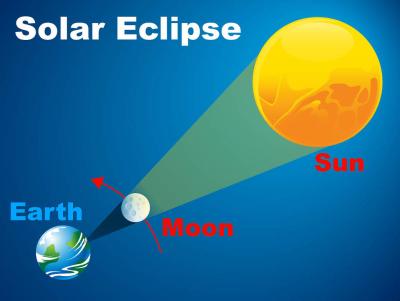
What is a solar eclipse?
During a solar eclipse the the Moon passes between the Sun and Earth and blocks all or part of the Sun. During a total solar eclipse, the Moon lines up perfectly to fully block the Sun; in a partial solar eclipse, the Moon only blocks part of the Sun; and during an annular eclipse, alignment is perfect but the Moon is too far away from the Earth to completely obscure the Sun.
This is different from a lunar eclipse, when the Earth blocks most of the sunlight that normally reaches the Moon. In a solar eclipse, the Sun gets darker; in a lunar eclipse, the Moon gets darker. Visit our lunar eclipse page to learn more.Watch this NASA video to learn more about the different roles of the Moon in lunar and solar eclipses.
More about solar eclipses: https://solarsystem.nasa.gov/eclipses
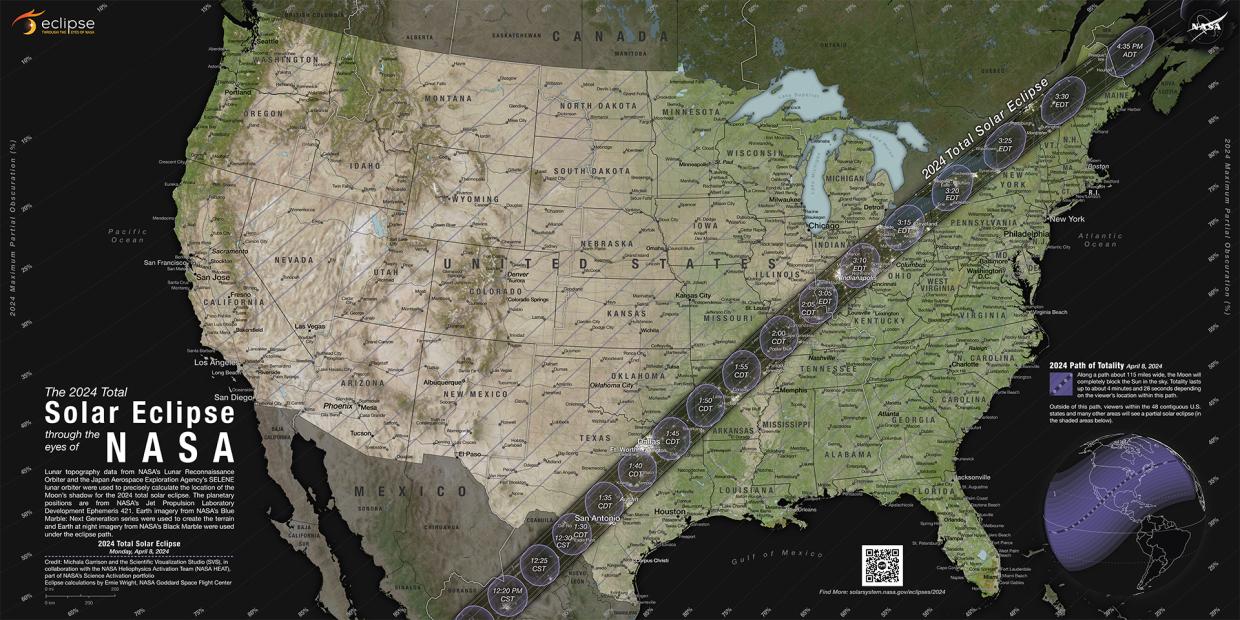
Solar eclipse map showing where the Moon’s shadow will cross the U.S. during the April 8, 2024 total solar eclipse.
Different versions and higher resolutions available for download: https://svs.gsfc.nasa.gov/5123/
Credit: NASA's Scientific Visualization Studio
Maps and Times
April 8, 2024 total solar eclipse (Monday)
- Where Can You See It?
You can see a partial eclipse, where the Moon covers only a part of the Sun, anywhere in North America (see "Who can see it?"). To see a total eclipse, where the moon fully covers the sun for a short few minutes, you must be in the path of totality. In 2024 the path of totality is a relatively thin ribbon, around 70 miles wide, that will cross the U.S. from Southwest to Northeast. States on the path of totality include: Texas, Oklahoma, Arkansas, Missouri, Illinois, Indiana, Kentucky, Ohio, New York, Vermont, New Hampshire, and Maine. - When Can You See It?
Times for viewing the eclipse vary depending on your location. These interactive maps will show you times for anywhere in the world.- Time and Date maps: https://www.timeanddate.com/eclipse/solar/2024-april-8
- NASA maps (different versions and higher resolutions available): https://svs.gsfc.nasa.gov/5123/
- NASA maps: https://science.nasa.gov/eclipses/future-eclipses/
- Great American Eclipse maps: https://www.greatamericaneclipse.com/april-8-2024
- National Eclipse maps: https://nationaleclipse.com/maps.html
More Upcoming Eclipses

Hands-on Activities During Your Event
- NISE Network activities: (available in English and Spanish)
- Big Sun, Small Moon activity
(included in Explore Science: Earth & Space 2017 toolkit) - Solar Eclipse activity
(included in Explore Science: Earth & Space 2017 toolkit) - Bear's Shadow activity
(included in Explore Science: Earth & Space 2017 toolkit) - Observe the Sun activity
(included in Explore Science: Earth & Space 2019 toolkit) - More NISE Network astronomy activities https://www.nisenet.org/astronomy
- More NISE Network early childhood activities https://www.nisenet.org/early-learner-earth-space
- Big Sun, Small Moon activity
- More activities:
- Pinhole projectors in the NSTA Booklet for Science Teachers and Other Educators
- More activities from NSTA Solar Science: Exploring Sunspots, Seasons, Eclipses, and More book by Dennis Schatz and Andrew Fraknoi
- Selected Eclipse Activities for Educators guide by Andrew Fraknoi (2023)
- Exploratorium activities https://www.exploratorium.edu/eclipse/activities
- NASA PUNCH Mission 3-hole punch pinhole projector activity
- NASA eclipse resources https://solarsystem.nasa.gov/eclipses/home/
- NASA activities https://solarsystem.nasa.gov/eclipses/resources/activities/
- NASA lesson plans and story map https://mynasadata.larc.nasa.
gov/phenomenon/solar-eclipse - NASA activities from 2017 https://eclipse2017.nasa.gov/activities
- NASA Parker Solar Probe activities
http://parkersolarprobe.jhuapl.edu/Participate/index.php#Learn - STARnet eclipse activities for libraries
- Eclipse Chalk Art (English) Eclipse Arte De Tiza (Spanish)
- more activities
- Protect and store your solar viewing glasses
- Store your solar viewing glasses safely to use again in the future using an envelope; you don't have to wait for a solar eclipse to use your glasses to view the Sun
- STARnet DIY storage case activity:
- Partner tip: Churro bags fit solar eclipse glasses well
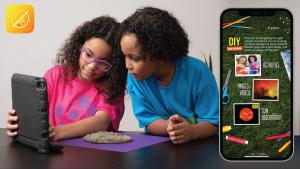
At-Home Activities and Apps
- DIY Sun Science App
DIY Sun Science includes 15 easy-to-use hands-on activities to learn about the Sun and its important relationship with Earth. Learn how to cook in a solar oven, measure the size of the Sun, or explore shadows in model Moon craters! Each activity includes step-by-step instructions that have been tested by educators, kids, and families. Activity materials are easily available and inexpensive. PDF versions of hands-on activities are also available for download in both English and Spanish.
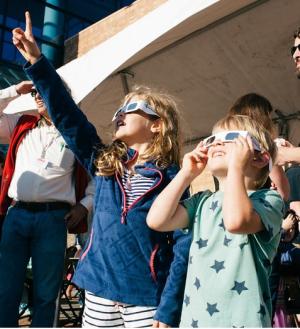
Safety
You never want to look directly at the sun without appropriate protection. That could severely hurt your eyes. However, there are numerous safe ways to view an eclipse.
An eclipse is a rare and striking phenomenon you won't want to miss, but you must carefully follow safety procedures. It is vital that you protect your eyes at all times. The only safe way to look directly at the uneclipsed or partially eclipsed Sun is through special-purpose solar filters, such as eclipse glasses or handheld solar viewers. Homemade filters or ordinary sunglasses, even very dark ones, are NOT safe for looking at the Sun.
Safe Viewing Techniques
Eclipse Glasses
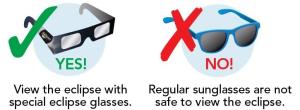
- Libraries: STARnet Solar Eclipse Activities for Libraries (SEAL) will be providing eclipse glasses AND training to libraries across the United States; learn more:
- https://www.starnetlibraries.org/about/our-projects/solar-eclipse-activities-libraries-seal/
- Be sure to purchase ISO certified eclipse glasses and hand-held solar viewers that meet safety standards.
- Rainbow Symphony
- American Paper Optics
- Thousand Oaks Optical
- EclipseGlasses.com (educator discount)
- The Astronomical League (quantity discounts! $0.35 each if purchasing 1,000)
- Vendor list from AAS
- Can I use my existing eclipse glasses? How to make sure your viewers are in good condition
- Look at a bright light (not the Sun) and make sure there aren't any holes.
- If the filters are torn, scratched, or punctured, discard them.
- If the filters are coming loose from their cardboard or plastic frames, discard them.
- How to Tell If Your Eclipse Glasses or Handheld Solar Viewers Are Safe
https://eclipse.aas.org/eye-safety/iso-certification
- Protect and store your solar viewing glasses
- Store your solar viewing glasses safely to use again in the future using an envelope; you don't have to wait for a solar eclipse to use your glasses to view the Sun
- STARnet DIY storage case activity:
- Partner tip: Churro bags fit solar eclipse glasses well
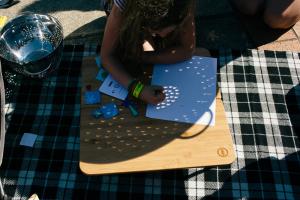
Shadows, Pinhole Viewers, and Projections
There are many ways that you can safely enjoy a partial or total solar eclipse
- How to make a pinhole projectors in NSTA Solar Science Insert by Dennis Schatz and Andrew Fraknoi (2017 eclipse)
- More activities from NSTA Solar Science: Exploring Sunspots, Seasons, Eclipses, and More book by Dennis Schatz and Andrew Fraknoi
- Pinhole and Optical Projections https://eclipse.aas.org/eye-safety/projection
- Exploratorium video Projection with binoculars
- NASA PUNCH Mission 3-hole punch pinhole projector activity
Sun Funnel
- How to make a sun funnel solar viewing projector that fits right over the eyepiece of your telescope to allow many people to observe the Sun simultaneously
https://eclipse2017.nasa.gov/make-sun-funnel
- How to make a sun funnel solar viewing projector that fits right over the eyepiece of your telescope to allow many people to observe the Sun simultaneously
Giant solar viewing glasses and tent designs
- DIY Resources for creating viewing opportunities for many people at once:
- Rolls of solar filter film: https://thousandoaksoptical.com/shop/solar-filters/bulk-rolls/
- Sheets of solar film https://thousandoaksoptical.com/shop/solar-filters/solarlite-filter-sheets/
- Plans shared by Derrick Pitts, Franklin Institute for a solar viewing tent
https://eclipse.aas.org/sites/eclipse.aas.org/files/Derrick_Pitts_Eclipse_Tent.pdf - Designs for giant solar viewing glasses structure:
https://cdn.makezine.com/make/86/full-size-eclipse-glasses.pd
- DIY Resources for creating viewing opportunities for many people at once:

Community Event Planning and Preparation
- Tips for hosting a solar eclipse viewing event
- If possible, plan many months in advance!
- A spacious location outside with horizon lines that will allow viewing (e.g. field or parking lot rather than forested area), can accommodate large crowds, and have necessary amenities for visitors
- Staff and volunteers to support the event by answering questions, facilitating activities, and demonstrating safe viewing
- Viewing equipment like projection techniques (DIY pinholes, colanders), solar eclipse viewing glasses, or special filters for cameras and telescopes. In case it’s cloudy– or even if it’s not– have a live stream set up!
NISE Network Online Workshops for 2023 and 2024 Solar Eclipse Event Planning
- Solar Eclipse Event Planning - Partners Share Plans for the 2024 Total Solar Eclipse (Recorded January 9, 2024)
- Solar Eclipse Event Planning - A Review of the Newest Resources for Engaging the Public (Recorded September 12, 2023)
- Kick-Start Your Planning for 2023 and 2024 Solar Eclipse Events (Recorded October 25, 2022)
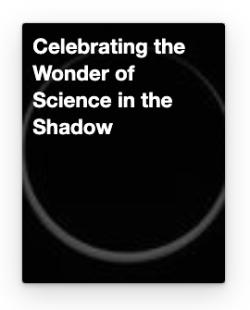
Bulletin of the American Astronomical Society (BAAS)
- BAAS has published a new special issue March 2024 entitled, "Celebrating the Wonder of Science in the Shadow."The publication is available online and is free to read and articles are free to download:
https://baas.aas.org/science-inthe-shadow
- BAAS has published a new special issue March 2024 entitled, "Celebrating the Wonder of Science in the Shadow."The publication is available online and is free to read and articles are free to download:
Astronomical Society of the Pacific and Eclipse Ambassadors:
- Off the central path:
How to Hold Partial Eclipse Parties in 2023 & 2024 one page (PDF download)
- Off the central path:
Neurodiversity planning - setting expectations
- These tips are helpful for all populations, not just neurodiverse learners
NASA's Neurodiversity Network (N3) eclipse guide
- These tips are helpful for all populations, not just neurodiverse learners
- AAS Community Planning for the 2023 and 2024 Solar eclipses
-
- American Astronomical Society (AAS) Solar Eclipse planning resources
https://eclipse.aas.org/resources/downloads - American Astronomical Society (AAS) Solar Eclipse Task Force
April 8-9, 2022 Solar Eclipse Planning Virtual Workshop - American Astronomical Society (AAS) Solar Eclipse Task Force - October 2022 Rochester planning resources
https://eclipse.aas.org/workshops/oct2022 - American Astronomical Society (AAS) Solar Eclipse Task Force video recordings and links from their workshop planning for the 2023 and 20234 events
https://eclipse.aas.org/workshops/2021 - Community event planning white paper from Dr. Kate Russo (2022)
- American Astronomical Society (AAS) Solar Eclipse planning resources
Funding Opportunities for April 2024 engagement events
- American Astronomical Society (AAS) Solar Eclipse Task Force mini-grant applications due November 10, 2023
- Simons Foundation through ASTC (only for locations directly on the path of totality) applications due by October 20, 2023
- Archive of Planning resources from the 2017 total solar eclipse
- Pages 13-16 of NISE Network Explore Science: Earth & Space 2017 Event Planning and Promotion Guide
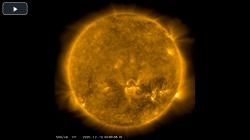
What should I do with my used solar eclipse safety viewing glasses?
- Save them for Solar Viewing
You can store your solar eclipse safety viewing glasses and use them for safely looking at the Sun anytime. Even without a telescope, it is possible to observe sunspots on the surface of the sun through eclipse glasses. According to the America Astronomical Society, If the filters aren't scratched, punctured, torn, or otherwise damaged, you may reuse them indefinitely.- Solar viewing resources:
- Exploring the Solar System: Observe the Sun
https://nisenet.org/catalog/exploring-solar-system-observe-sun - DIY Sun Science App
https://nisenet.org/diy-sun-science-app
- Exploring the Solar System: Observe the Sun
- Solar viewing resources:
- Donations
Several organizations collect used eclipse glasses so that they can be used for future solar eclipses in other parts of the world.- Glasses must be in good condition, without perforations, tears, or punctures.
- Astronomers Without Borders collection locations
https://astronomerswithoutborders.org/programs/solar-glasses-distribution Warby Parker stores nationwide are serving as donation locations for Astronomers Without Borders
find a store: https://www.warbyparker.com/retailEclipse Glasses USA
Glasses can be mailed to:
Eclipse Glasses USA, LLC
PO BOX 50571
Provo, UT 84605
https://eclipse23.com/pages/donate-eclipse-glasses
- Recycle and Disposal
If you are going to throw out your eclipse glasses, you can remove the lenses and recycle the cardboard frame. The lenses themselves aren’t recyclable, so you should toss them in the trash.

Handouts
- NASA Eclipse Fact Sheet (evergreen without dates)
https://solarsystem.nasa.gov/resources/2689/eclipse-fact-sheet/ - NASA 2024 solar eclipse fact sheet (English)
- NASA 2024 solar eclipse fact sheet (English & Spanish)
- AAS Postcard artwork 4-by-6-inch - Front (PDF) and Back (PDF)
more details: https://eclipse.aas.org/resources/downloads - AAS Business Card artwork - Side 1 - 2023 (PDF) and Side 2 -2024 (PDF)
more details https://eclipse.aas.org/resources/downloads
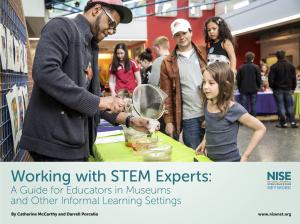
Finding STEM Experts
We encourage you to seek out local experts for your public events. Many astronomy enthusiasts plan to travel to the path of totality, but many will be staying closer to home, so please check out all of these different resources to find experts near you:
- Finding and Collaborating with STEM Experts: see the "Space and Earth Sciences" section of the Working with STEM Experts: A Guide for Educators in Museums and Other Informal Learning Settings
- Finding astronomy volunteers - summary and link to recorded online workshop
- Sources of expertise:
- Solar System Ambassadors - NASA trained volunteers located throughout the US
- Night Sky Network of astronomy clubs
- ASP NASA Partner Eclipse Ambassadors
- AAS Astronomy Ambassadors
- NSTA booklet How to Find an "Eclipse Expert" in Your Community
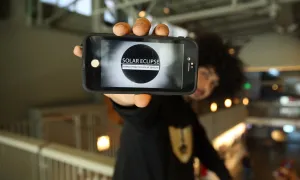
Live Streaming of the Solar Eclipse
The Exploratorium will be live streaming the solar eclipses in 2023 and 2024 in multiple formats including on mobile devices; options include telescope imagery without narration as well as educational programming and narration in English and Spanish:
- Exploratorium live stream
https://www.exploratorium.edu/eclipse
https://www.exploratorium.edu/eclipse/livestream - Exploratorium live stream solar eclipse app (available on Apple App Store and Google Play)
https://www.exploratorium.edu/explore/apps/total-solar-eclipse-app
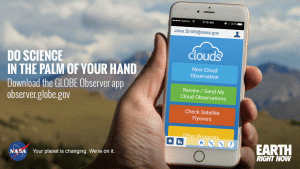
Citizen Science and Community Science Projects
A solar eclipse presents many opportunities for amateur astronomers and lifelong learners to get in on the fun of doing science.
- Eclipse Soundscapes project studying how eclipses affect life on Earth
How does wildlife respond to a solar eclipse? Record sounds before, during, and after an eclipse to find out!
https://eclipsesoundscapes.org - GLOBE Observer app
How does the solar eclipse affect the atmosphere on Earth? nation-wide science experiment by collecting cloud and temperature data
Use GLOBE Observer app and a thermometer to measure air temperature changes and monitor the clouds during the eclipse.
https://observer.globe.gov/do-globe-observer/eclipse
https://observer.globe.gov/toolkit/eclipse-toolkit - Solar Eclipse Safari
Discover how animals react during the total solar eclipse.
https://scistarter.org/solar-eclipse-safari-resources - SunSketcher
Use your phone to help measure the exact shape and size of the Sun by photographing an eclipse phenomenon called Baily’s Beads.
https://sunsketcher.org/ - More NASA citizen science projects
https://science.nasa.gov/eclipses/citizen-science/ - Dynamic Eclipse Broadcast (DEB) Initiative
Citizen science team observing and web broadcasting the 2023 and 2024 solar eclipses
https://debinitiative.org/
Multimedia - Animations and Visualizations
- NASA Scientific Visualization Studio animations https://svs.gsfc.nasa.gov/14527/
- NASA Eyes April 2024 - embeddable, interactive, 3D simulation where you can see what the eclipse would look like from anywhere on the planet, and see exact timing of the different phases.
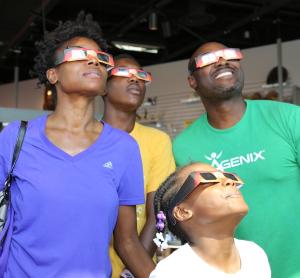
Promotional Images and Photos
Images and videos of solar eclipses and people experiencing for educational and promotional purposes
- AAS Image gallery https://eclipse.aas.org/resources/images-videos
- NISE Network SmugMug gallery 2017 at OMSI
- NISE Network SmugMug gallery 2017 at Science Museum of Minnesota
- NASA eclipse gallery https://solarsystem.nasa.gov/eclipses/resources/gallery/
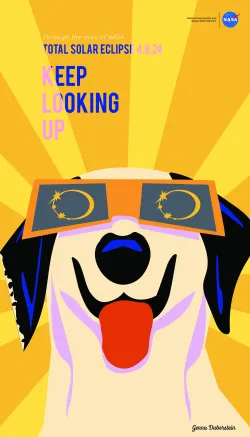
Posters
- Please also see maps section above
- NASA Tyler Nordgren's Poster
https://solarsystem.nasa.gov/resources/2918/2023-annular-eclipse-poster… - NASA Kristen Perrin's Poster
https://solarsystem.nasa.gov/resources/2919/2023-annular-eclipse-poster… - NASA Dongjae “Krystofer” Kim Poster
https://science.nasa.gov/resource/2024-total-eclipse-poster-dongjae-krystofer-kim/ - NASA Genna Duberstein dog Poster
https://science.nasa.gov/resource/2024-total-eclipse-poster-genna-duberstein/ - NASA solar eclipse map poster
Solar eclipse map showing where the Moon’s shadow will cross the U.S. during the April 8, 2024 total solar eclipse. Different versions and higher resolutions available for download: https://svs.gsfc.nasa.gov/5123/ - Navajo knowledge of solar eclipse poster features the Diné language and descriptions of eclipses from the Navajo worldview developed by Exploratorium in collaboration with the Indigenous Education Institute
https://www.exploratorium.edu/eclipse/navajo-understanding-eclipses - ASP Eclipse Ambassadors 2023-2024 Celebrate Our Marvelous Moon Poster
These celebrations follow lunar calendars, so their dates change each year. Humans have used the Moon’s phases to track time since the beginning of recorded history.This is reflected in many current cultural traditions like these.
Request form for receiving printed poster in the mail - ECHO, Leahy Center for Lake Champlain, Burlington, Vermont printable exhibit posters
https://www.echovermont.org/wp-content/uploads/2024/01/ECHO_EclipseExhibit_Full.pdf
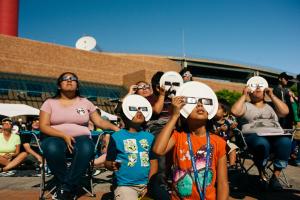
Taking Photos and Videos
- American Astronomical Society (AAS) advice for shooting still or video of a solar eclipse
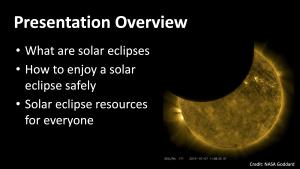
Slides
- NISE Network PowerPoint slide presentation (revised September 13, 2023)
Preparing for a Solar Eclipse slide presentation - NASA solar eclipse training slides
PPTXhttps://science.nasa.gov/learn/heat/resource/total-solar-eclipse-training/ - GLOBE Observer app training slides available as a PDF, PPTX, and Google Slides
https://observer.globe.gov/toolkit/eclipse-toolkit
Videos
- For public audiences:
- Exploratorium series of videos on safe viewing and eclipse science
- Fiske Planetarium Science through Shadows videos (full dome and flatscreen short films in English and Spanish)
- NASA video to learn more about the different roles of the Moon in lunar and solar eclipses
- NASA Space Place Video
- NASA MinuteEarth and MinutePhysics eclipse videos on YouTube
- MinuteEarth video Weird Thing Animals Do During Eclipses
- MinutePhysics Why Aren't There Eclipses Every Month?
- Night Sky Network April 2024 Solar Eclipse Info in 10 Languages
- GBH Why Isn’t There an Eclipse Every Month?
Simons Foundation In the Path of Totality: the 2024 Total Solar Eclipse
An Astronomer's Guide to the 2024 Total Solar Eclipse
- For educators:
- Videos of people experiencing a solar eclipse:
Schools and Libraries
- NSTA Booklet for Science Teachers and Other Educators http://bit.ly/eclipsesforteachers
- NSTA Booklet for School Administrators http://bit.ly/eclipsesforadministrators
- NSTA Booklet for Librarians and Library Patrons http://bit.ly/eclipsesforlibraries
- NSTA eclipse resources http://www.nsta.org/eclipse
- Scholastic solar eclipse activities, stories, and videos
- STARnet Solar Eclipse Activities for Libraries (SEAL) will be providing eclipse glasses AND training to libraries across the United States; learn more:
https://www.starnetlibraries.org/about/our-projects/solar-eclipse-activities-libraries-seal/ - STARnet eclipse activities for libraries
Planetarium Shows
- Fiske Planetarium Science through Shadows videos
(full dome and flatscreen short films in English and Spanish) - Rice University Totality full-dome planetarium show
https://space.rice.edu/eclipse/eclipse_show.html - Observing Our Star - Live and Interactive Planetarium Learning Resources
https://stemgateway.nasa.gov/connects/s/article/Observing-Our-Star
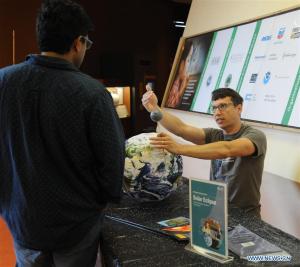
Training for Staff and Volunteers
- Please also see sections on slides and community event planning resources above
- NISE Network PowerPoint slide presentation (revised September 13, 2023)
Preparing for a Solar Eclipse slide presentation - NISE Network background content training video for solar eclipse activities
- NASA Partner Eclipse Ambassadors amateur astronomers and undergraduate students are invited to apply
- STARnet Solar Eclipse Activities for Libraries (SEAL) training for libraries
- NASA Updates for Non-NASA Funded Eclipse Enthusiasts (newsletter)
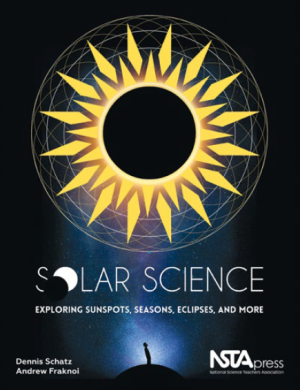
Books and Booklets
- AAS compilation of solar eclipse books: https://eclipse.aas.org/resources/books-articles
- NSTA: Solar Science: Exploring Sunspots, Seasons, Eclipses, and More
by: Dennis Schatz and Andrew Fraknoi, NSTA- NSTA Booklet for Science Teachers and Other Educators: http://bit.ly/eclipsesforteachers
- NSTA Booklet for School Administrators: http://bit.ly/eclipsesforadministrators
- NSTA Booklet for Librarians and Library Patrons: http://bit.ly/eclipsesforlibraries
- NSTA How to Find an "Eclipse Expert" in Your Community: http://bit.ly/eclipseexpert
- NSTA Fiction, Music, Films, and other Creative Expressions Inspired by Eclipses: http://bit.ly/eclipsesand
- NSTA Basic Activities about Eclipses, the Moon, and the Sun that are Free on the Web: http://bit.ly/teacheclipse
- When The Sun Goes Dark
by: Andrew Fraknoi and Dennis Schatz, NSTA
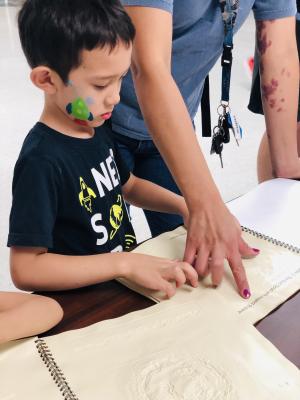
Sensory Resources
- Tactile Books
NISE Network strives to share STEM public engagement resources designed to for all audiences, including blind and visually impaired participants https://www.nisenet.org/blind-low-vision
For more information about how NISE Network products are designed with an inclusive audiences approach using Universal Design principles, visit https://www.nisenet.org/Audiences.- Getting a Feel for Eclipses
available from NASA SSERVI Tactile and Braille Books https://sservi.nasa.gov/books/
NISE Network has distributed tactile books to partners in 2017, 2020, and 2023
- Getting a Feel for Eclipses
- Eclipse Soundscapes project studying how eclipses affect life on Earth
https://eclipsesoundscapes.org - NASA PUNCH Mission - Seeing the Sun's corona with your hands activity
https://punch.space.swri.edu/punch_outreach_seeing-with-your-hands.php - GLOBE Observer app
How does the solar eclipse affect the atmosphere on Earth? nation-wide science experiment by collecting cloud and temperature data
https://observer.globe.gov/do-globe-observer/eclipse
https://observer.globe.gov/toolkit/eclipse-toolkit - LightSound
LightSound device tool for the Blind and Low Vision (BLV); the device uses a technique called sonification which is the process of converting data (or light intensity in this case) to sound
https://astrolab.fas.harvard.edu/LightSound.html#documentation - Observing things you feel, see, and hear around you
- Sound Map activity - Observing, Recording, and Journal
https://www.sciencebuff.org/scienceactivity/sound-map/ - Observing Animals
MinuteEarth video Weird Thing Animals Do During Eclipses - Recording Observation Worksheet
- Sound Map activity - Observing, Recording, and Journal
Neurodiversity planning - setting expectations
These tips are helpful for all populations, not just neurodiverse learners
NASA's Neurodiversity Network (N3) eclipse guide
https://n3.sonoma.edu/N3FlyerASTC100523.pdf
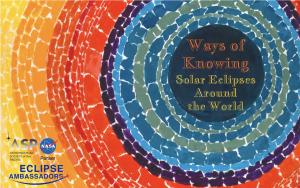
Cultural Connections
- Astronomical Society of the Pacific Ways of Knowing: Solar Eclipses Around the World (PDF)
available as PPTX and Google Slides
https://astrosociety.org/education-outreach/eclipse.html - Indigenous Education Institute (IEI) Indigenous Eclipse Teachings Video - includes Navajo and Cherokee teachings on solar eclipses
- Navajo Knowledge of the Cosmos including solar eclipse poster by Exploratorium in collaboration with the Indigenous Education Institute https://www.exploratorium.edu/eclipse/navajo-understanding-eclipses
- National Museum of the American Indian - American Indian Beliefs About the Eclipse (2017)
- Myths and Superstitions Around Solar Eclipses
- Resources Connecting Eclipses and Other Fields (Particularly the Humanities) compiled by Andrew Fraknoi (2022) (connections to fiction, films, art)
Night Sky Storytelling
- The Astronomy of Many Cultures: A Resource Guide compiled by Andrew Fraknoi
- NASA's Universe of Learning Native American Sky resources:
https://universe-of-learning.org/contents/events/science-briefings/science-briefing-the-native-american-sky - Audio stories about the Moon from Lunar Planetary Institute (LPI)
https://www.lpi.usra.edu/education/explore/marvelMoon/tales/ - Moon myths from around the world - Night Sky Network and Astronomical Society of the Pacific (ASP)
https://nightsky.jpl.nasa.gov/download-view.cfm?Doc_ID=642
Downloadable handout: https://nightsky.jpl.nasa.gov/docs/MoonStoriesASP2019.pdf
Create your own Moon story handout: https://nightsky.jpl.nasa.gov/docs/CreateMoonStory.pdf - Cosmic Serpent - Bridging Native Ways of Knowing and Western Science in Museum Settings
https://www.informalscience.org/sites/default/files/CS-LegacyDoc27Nov2012.pdf - Native Sky Watchers - Two Eyed Seeing – NASA & Indigenous Astronomy – For the Benefit of All
https://www.nativeskywatchers.com/two-eyed-seeing-nasa.html - Indigenous Education Institute (IEI): http://indigenouseducation.org
- Smithsonian National Museum of the American Indian Star Stories:
https://www.youtube.com/playlist?list=PLS6nSmuURFJBLIE-4ulPJMYxOV4Zpj1WZ - Learn more about Indigenous ways of knowing and making local connections in the NISE Network guide Working with STEM Experts: A Guide for Educators in Museums and Other Informal Learning Settings
